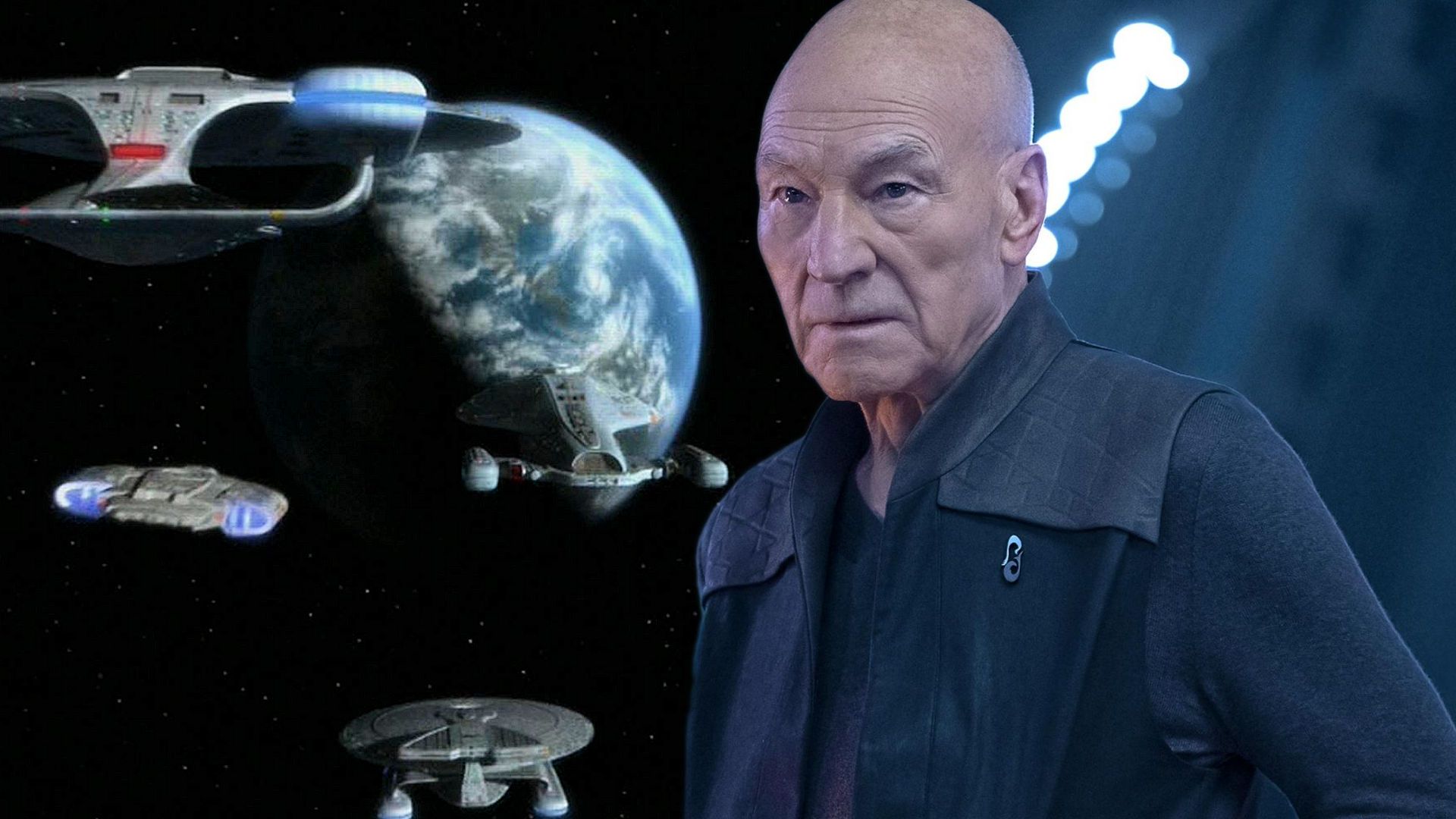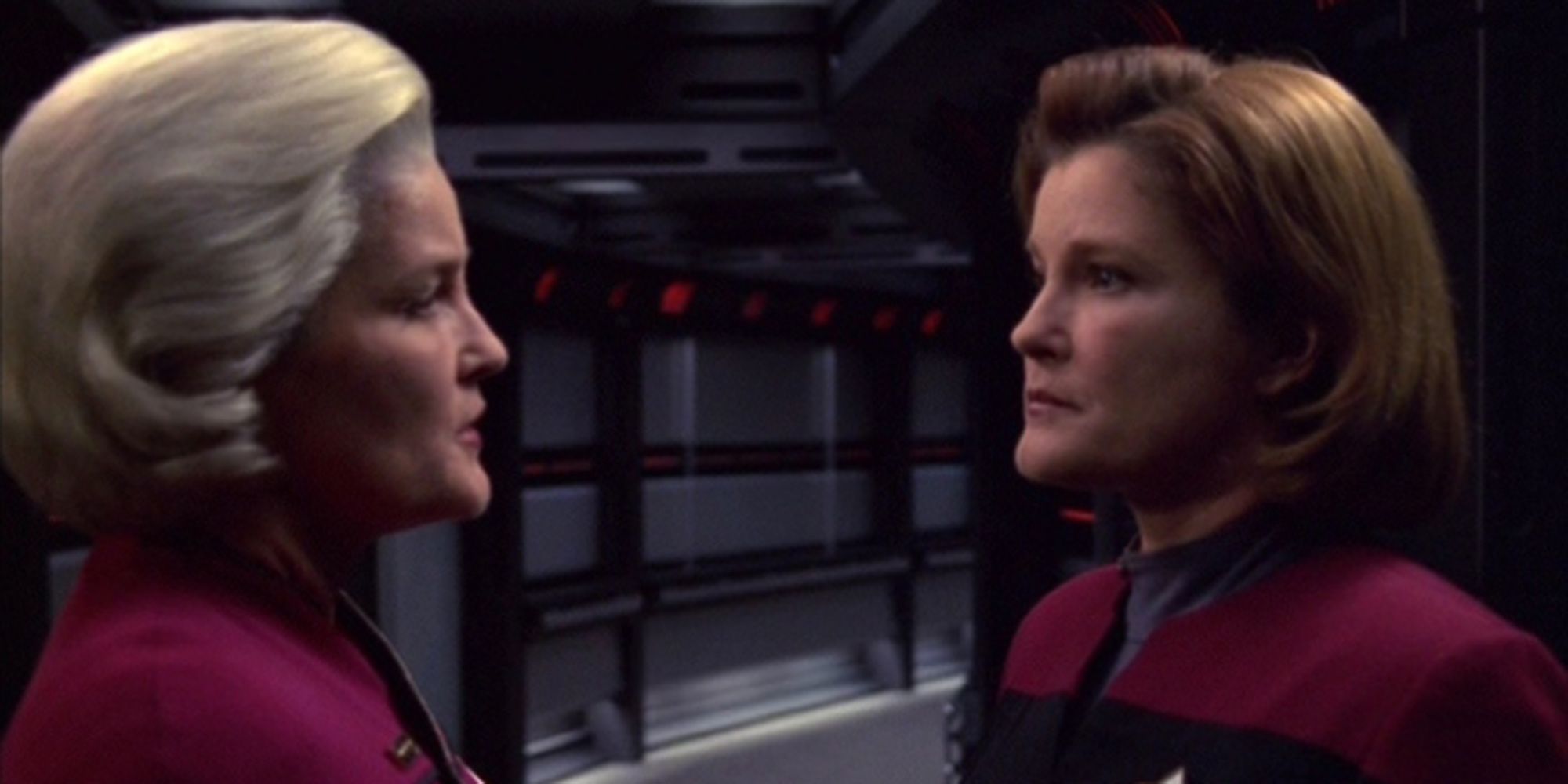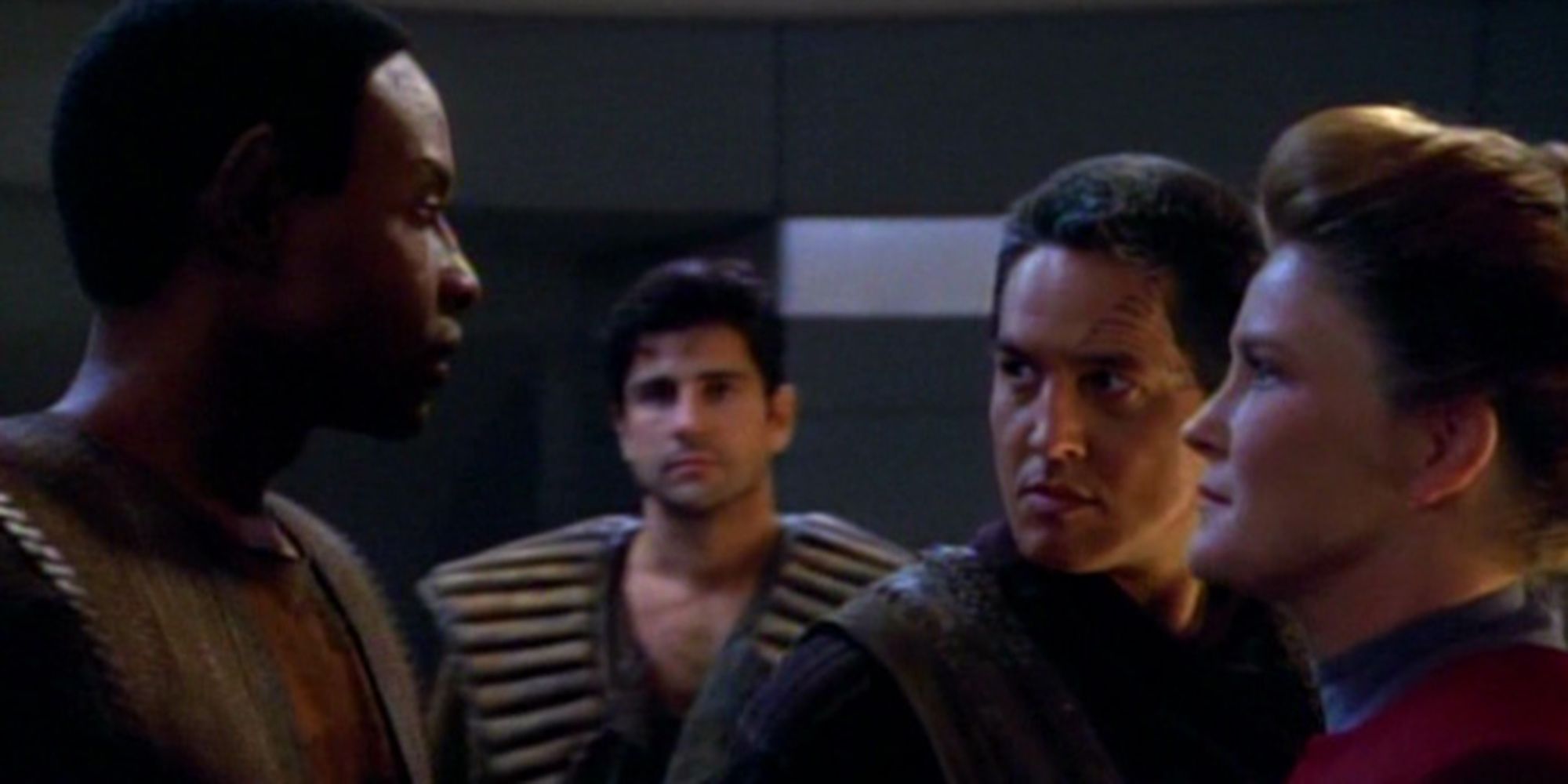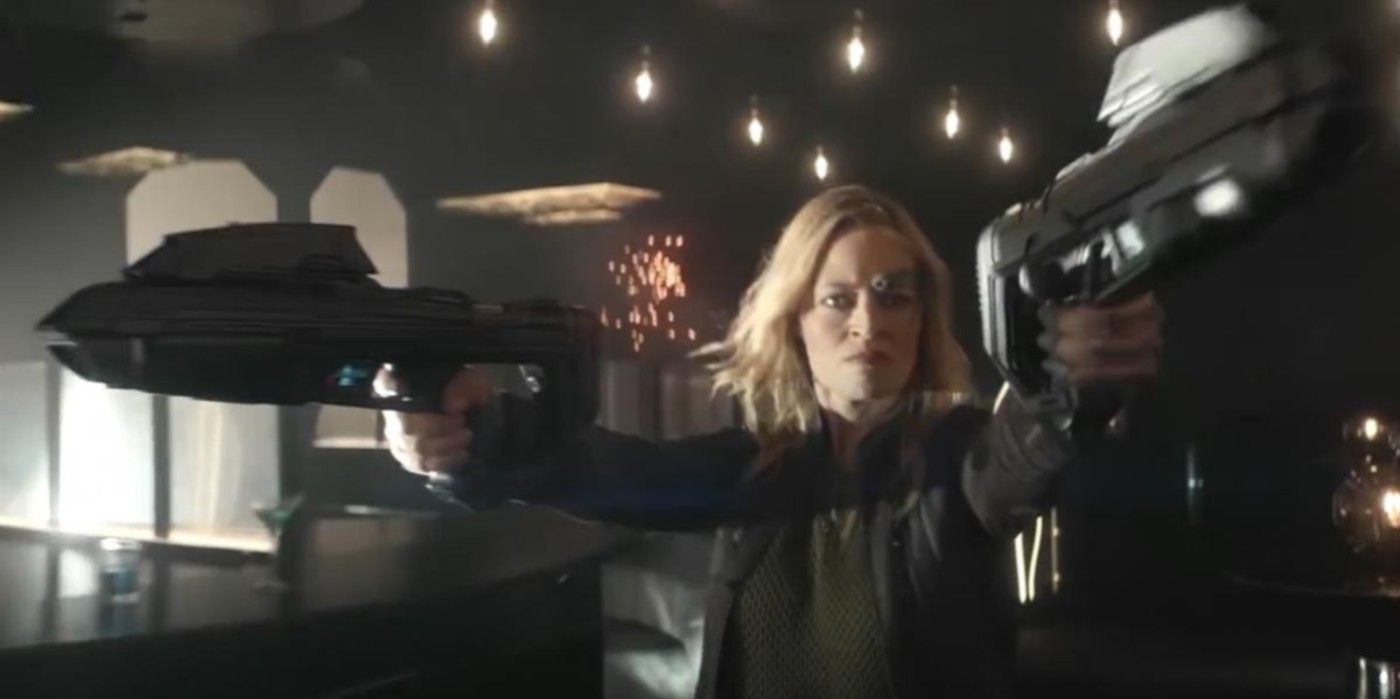The finale of Star Trek: Voyager caused a few plot holes that the show never had time to address, but Star Trek: Picard could take the opportunity to clear up some of the questions fans still have. The series finale of Voyager, titled "Endgame" saw the crew of the USS Voyager finally returning home from their long journey through the Delta Quadrant, aided by a future version of their captain, the now-Admiral Kathryn Janeway. "Endgame" managed to tie up a number of loose ends for the series, the biggest being the crew's successful homecoming. Along with this, Admiral Janeway managed to avert several cataclysmic events that would have befallen the crew, and Tom Paris and B'Elanna Torres also got a sweet conclusion to their love story through the birth of their daughter, a storyline that had been building all season.
"Endgame" may have wrapped some things up nicely, but there were also a number of plot holes created by the episode. Ending without showing the bulk of Voyager's homecoming raised a lot of questions about what may have happened to the crew after they got back to Earth. Because of being stranded in the Delta Quadrant, Voyager's crew were able to break some rules they wouldn't have been able to otherwise. Returning to Federation space however would mean that such issues as the Maquis crewmembers, Seven of Nine's Borg identity, and Janeway's violation of the Temporal Prime Directive would need to be addressed, something that fans never got to see during the conclusion of "Endgame".
Luckily, Star Trek: Picard might be able to fill some of these gaps. Picard, which premiered in 2020, takes place just over twenty years after the end of Voyager and the two shows are already linked with Picard bringing back Seven of Nine as part of the main cast. Picard has the chance to address and explain the major plot holes that "Endgame" never got around to and could go a long way to giving Voyager fans a better sense of closure about their favorite series.
Captain Janeway Breaks Time Travel Rules
Time travel features heavily in Star Trek: Voyager, so the fact that the main storyline in "Endgame" centered around it is not a shock. In an effort to help her former crew get home sooner, Admiral Janeway steals technology from the Klingons which she uses to send herself back in time and aide Voyager in using a Borg transwarp conduit to get back to the Alpha Quadrant. Her actions are a serious violation of the Temporal Prime Directive, a Starfleet principle that expressly forbids officers from changing the timeline or meddling in events both past and future. By helping Voyager, Admiral Janeway rewrote the future and doomed her own timeline never to exist, meaning that anything she or anyone else did during that timeline might never happen, or might happen differently if it still does.
The Admiral broke the directive two-fold when she decided to tell her younger self about events in the future, events such as the deaths of Seven of Nine and Chakotay and Tuvok's severe mental deterioration due to a brain disease. While Voyager's homecoming helped ensure these events did not end up happening, time travel is notoriously tricky, and both Janeways' actions could have had unintended consequences. It is possible that the deaths and suffering of the crew could still have taken place, just under different circumstances.
The convoluted nature of time travel and of the Janeways' plan is enough to create a sizable plot hole surrounded the timeline in "Endgame", but one that can be fixed with some explanations in Star Trek: Picard. Whether or not Janeway was disciplined for her and the Admiral's actions, it is a safe bet that at some point after returning to Earth, Starfleet would have to address the fact that the timeline was altered significantly by what the two of them had done. Since it is set 20 years in the future, Picard has the ability to explore the ripple effects of the timeline shift caused by Voyager, and could even choose to pinpoint specific events that were the result of it. The show has already established that Seven of Nine is not dead in the new version of the future, but there has yet to be much mention of any other members of the Voyager crew, including Chakotay and Tuvok. Star Trek: Picard could choose to still have them fulfill their tragic destinies, addressing the time travel rules broken in "Endgame" and proving that all actions have consequences
The Maquis Crew Are Former Terrorists
One of the biggest ongoing storylines on Star Trek: Voyager dealt with the integration of the former Maquis into Voyager's Starfleet crew. This was of more importance in early seasons, while the two crews still struggled to find common ground. Ultimately, by the time "Endgame" aired, both crews had put aside their differences and become unified as camaraderie was fostered by their isolation. While circumstances necessitated this out in the Delta Quadrant, the rest of the Maquis in the Alpha Quadrant were not given the chance to reach such an amicable resolution with the Federation.
While Voyager was in the Delta Quadrant, the Federation was fighting the Dominion War, a conflict the would ultimately prove to be the Maquis' undoing. After agreeing to join the Dominion, The Cardassians launched a massive offensive against the Maquis with the help of the Jem'Hadar. Unfortunately for the Maquis, this offensive was devastatingly successful. Almost all of the resistance force was killed, and those who weren't were imprisoned by the Federation. While it is true that the Maquis ceased to become a problem after they were decimated, they were still considered a terrorist organization, and those who remained at-large would all have had to face Federation justice eventually. This presumably would have included the former Maquis on Voyager, but because "Endgame" chose to show hardly any of Voyager's return to the Alpha Quadrant, the question of what happened to their Maquis was left unanswered.
Star Trek: Picard could provide a few details about what the return of Voyager's Maquis contingent meant for those who were left after their decimation during the Dominion War. It is established that there were a few small pockets of former Maquis after the massacre, but one of the largest were those on Voyager. Picard has the opportunity to show whether or not any of Voyager's Maquis crew were made to face justice for their actions, or if the Federation considered them rehabilitated. "Endgame" never addresses if the former Maquis still feel any allegiance to their old organization or not; the crew is so focused on getting home all other concerned are pushed aside. But it is very possible that some of Voyager's former Maquis returned to their old ways upon getting home, or more likely that they integrated back into Federation society. By deciding on an answer to these questions, Picard would finally be able to fill some gaps in Star Trek fans' knowledge.
Seven of Nine Was Borg — Starfleet's Enemy
The Borg have always been a formidable threat to the Federation, and Star Trek: Voyager had several Borg-related storylines during its later four seasons. The Borg were the other half of the plan to get home during "Endgame", with the ship taking advantage of a Borg transwarp conduit while Admiral Janeway distracts the Borg Queen from their escape. A large portion of the Borg-related storylines on the show though focused on Seven of Nine.
Seven of Nine was introduced at the beginning of Voyager season 4 and quickly became a fan-favorite character. A former Borg drone rescued and rehabilitated by Voyager's crew, many of Seven's storylines revolved around reclaiming her identity and humanity, a daunting task in the face of what had been done to her by the Collective. Just like the Maquis and any consequences from changing the timeline though, "Endgame" never addressed what Seven's status as a former drone meant for her prospects in Federation space, leaving fans to wonder if Starfleet welcomed her with open arms or regarded her as an enemy.
Luckily, unlike the other plot holes from "Endgame", Star Trek: Picard has already provided some detail on Seven's status and what happened to her after the end of Voyager. One of Picard season 1's most prominent storylines revolved around the Federation's ban on synthetic life forms after a group of rogue androids attacked the Romulan rescue fleet convened on Mars. Since Seven's body still contains a fair amount of Borg technology, and since it is revealed that she has abandoned Starfleet by the time of Picard season 1, the implication is that the ban on synthetics forced Seven out of the Federation. Picard also addresses Starfleet's somewhat tenuous relationship with the Borg, showing that more ex-Borg drones have begun reclaiming their identities, forcing the galaxy to reckon with the fact that drones are as much victims of the Borg as everyone else.
By including Seven in Picard, the series has already added information that explains her life after "Endgame". The show has yet to address Seven's story fully, however, something fans are hopeful it will do in season 2. Star Trek: Voyager fans were left with almost more question than answers from "Endgame", and if Star Trek: Picard can fill in the holes that the episode left behind, it would be a big draw for classic Star Trek fans who are potentially wary about the newer shows in the franchise.




